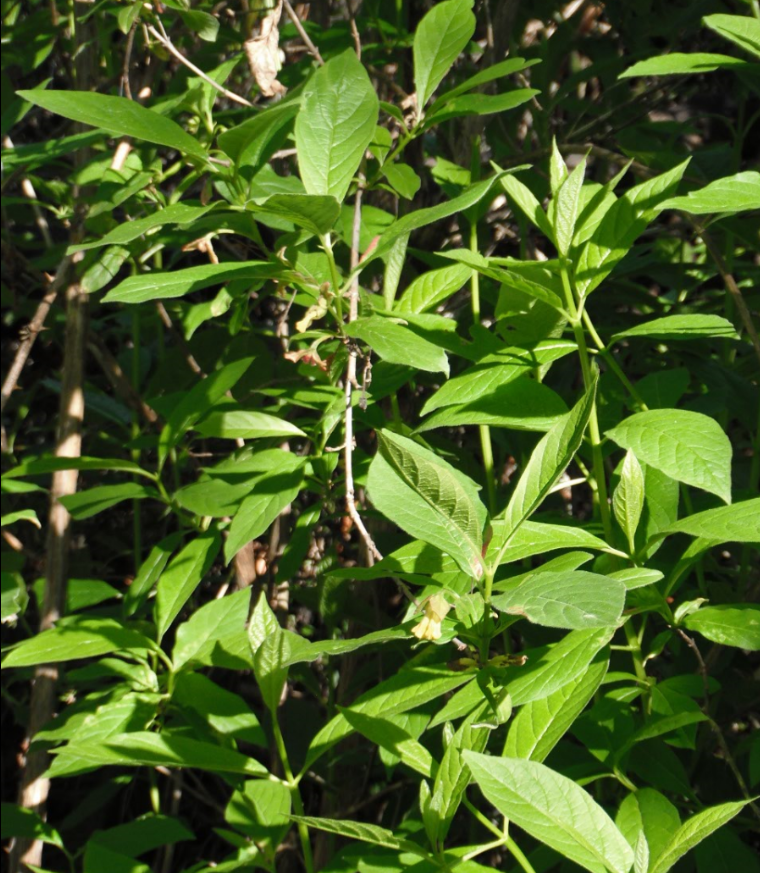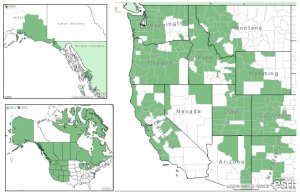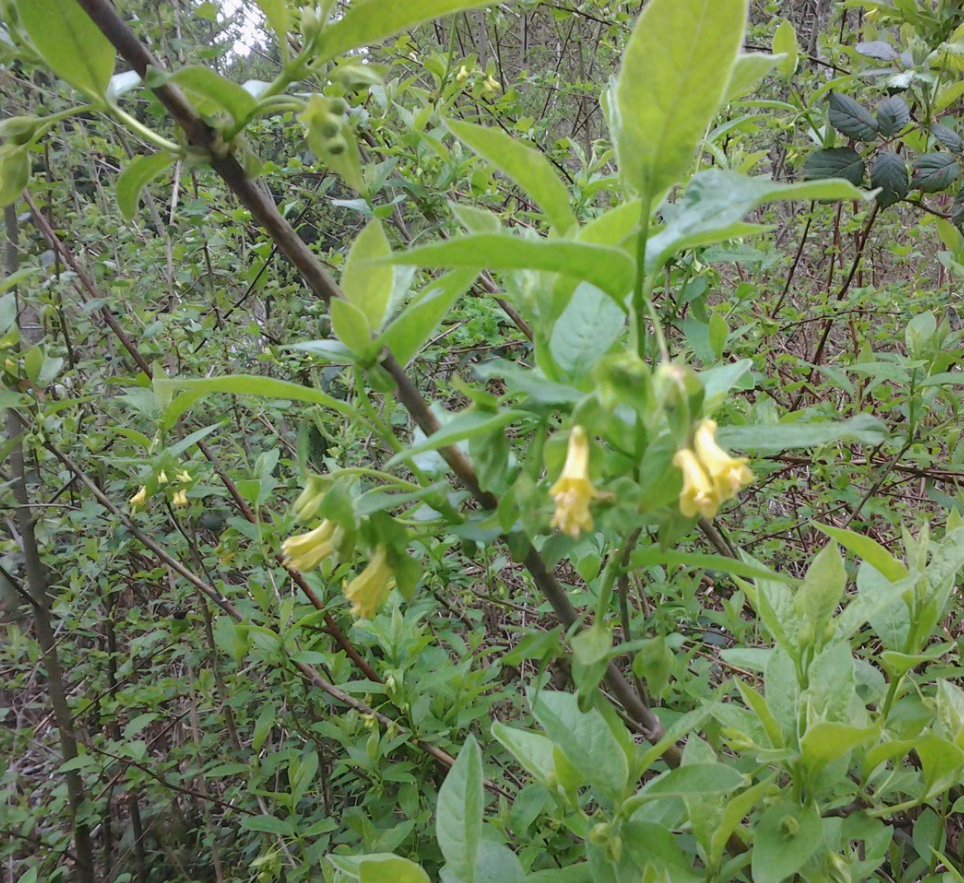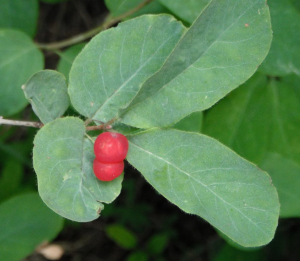Black Twinberry Caprifoliaceae-the Honeysuckle Family
Lonicera involucrata (Richardson) Banks ex Spreng.
(Lon-IH-sir-ruh in-voh-loo-KRAY-tuh)
 Names: Black Twinberry is also known as Involucred, Bracted, Bearberry, Fly or Fourline Honeysuckle; or Coast Twinberry. Involucrata refers to the involucres, or bracts that surround the flowers and fruit. Twinberry refers to the 2 berries surrounded by the bracts.
Names: Black Twinberry is also known as Involucred, Bracted, Bearberry, Fly or Fourline Honeysuckle; or Coast Twinberry. Involucrata refers to the involucres, or bracts that surround the flowers and fruit. Twinberry refers to the 2 berries surrounded by the bracts.
Relationships: Honeysuckles have long been a garden favorite, grown mostly for their sweetly-scented, nectar-producing flowers. The common name, honeysuckle, comes from the fact that children enjoy sucking nectar from the base of the flowers for a sweet treat. Plants in the genus, Lonicera, are often twining vines but many are arching shrubs. There are about 180 species in the Northern Hemisphere, with about 100 from China, ~20 from North America, and the rest from Europe or North Africa. The name Lonicera is derived from Adamus Lonicerus (Adam Lonitzer), a German botanist, author of the herbal, Kräuterbuch (1557). Unfortunately, many invasive ornamental species of Lonicera may be found growing in natural areas.

Distribution of Black Twinberry from USDA Plants Database
Distribution: This species is found from southeast Alaska to southern California; across most of Canada; from western Montana to Chihuahua in northern Mexico; with isolated communities in the Great Lakes region; listed as endangered in Wisconsin and threatened in Michigan.
Growth: It grows from 1.5-9 feet (.5-3m)

Habitat: Black Twinberry is found in moist, open forests, streamsides, and edges. Wetland designation: FAC+*, Facultative, it is equally likely to occur in wetlands or non-wetlands.
 Diagnostic Characters: Black Twinberry has opposite leaves that are broadly lance-shaped. It has paired, tubular, yellow flowers arising from the leaf axils. The flowers are 5-lobed, surrounded by large, green or purple bracts. Fruits are shiny, black “twin” berries surrounded by purplish-red bracts. Young, green twigs are 4-angled in cross-section.
Diagnostic Characters: Black Twinberry has opposite leaves that are broadly lance-shaped. It has paired, tubular, yellow flowers arising from the leaf axils. The flowers are 5-lobed, surrounded by large, green or purple bracts. Fruits are shiny, black “twin” berries surrounded by purplish-red bracts. Young, green twigs are 4-angled in cross-section.
 In the Landscape: It is an attractive shrub and should be used more in the garden. It is a great “edge” species when planted between a forest and more open area. It can be used in a hedgerow or in a Rain Garden. Its fresh, green leaves are similar to Indian Plum; and its dainty, yellow flowers and colorful bracts add interest throughout spring, summer, and fall. Black Twinberry is great for reclamation plantings on riparian sites, in wet meadows and in forests.
In the Landscape: It is an attractive shrub and should be used more in the garden. It is a great “edge” species when planted between a forest and more open area. It can be used in a hedgerow or in a Rain Garden. Its fresh, green leaves are similar to Indian Plum; and its dainty, yellow flowers and colorful bracts add interest throughout spring, summer, and fall. Black Twinberry is great for reclamation plantings on riparian sites, in wet meadows and in forests.
Phenology: Bloom time: April-August (May at peak); Fruit ripens: September.

Propagation: Stratify seeds at 38º (3º C) for 120 days or sow them as soon as they are ripe in a cold frame. Cuttings of half-ripe wood may be taken in July or August or of mature wood in November. Layering in the fall is also possible.
Use by People: Natives used the leaves, bark and twigs for a variety of medicinal purposes. An infusion of bark was used as a soak for sore feet and legs, as an eyewash, or in the treatment of coughs. Women chewed the leaves during confinement. Leaves were also chewed and applied to itchy skin and various sores. The berries were mostly considered poisonous, but were sometimes eaten for food. The fruit or leaves were used to induce vomiting for purification or after poisoning. The berries were applied to the scalp to prevent dandruff or to prevent hair from turning gray. The juice of the berries was used to paint the faces of dolls and for basketry dye.
Use by Wildlife: Most tribes associate this plant with the crow; other birds such as grouse, grosbeaks, juncos, waxwings, thrushes, flickers, finches, and quail eat the berries too. Bears also eat the berries. Black Twinberry provides cover for small animals. Although hummingbirds may visit Twinberry flowers, they are mostly pollinated by insects, as are many “Fly Honeysuckles.”
Links:
Consortium of Pacific Northwest Herbaria
WTU Herbarium Image Collection, Plants of Washington, Burke Museum
E-Flora BC, Electronic Atlas of the Flora of British Columbia
Jepson Eflora, University of California
Ladybird Johnson Wildflower Center
Native Plants Network, Propagation Protocol Database
Native American Ethnobotany, University of Michigan, Dearborn
 Red Twinberry
Red Twinberry
Lonicera utahensis S. Watson
Red Twinberry is similar to Black Twinberry but has more rounded leaves and lacks the big bracts surrounding the flowers and fruit; it has red fruit and its flowers are a creamy-yellow, nearly white. It is found from southern British Columbia to central Oregon in the Olympic Mountains, North Cascades, and central Oregon; and in the Rocky Mountains from Alberta to the border of Arizona and New Mexico. It can be used similarly in the landscape as Black Twinberry. It is a valuable summer and fall browse for elk, but a minor browse species for white-tailed deer and moose. Fruits are dispersed by birds, such as grouse, rodents, and bears.
Links:
Consortium of Pacific Northwest Herbaria
WTU Herbarium Image Collection, Plants of Washington, Burke Museum
E-Flora BC, Electronic Atlas of the Flora of British Columbia
Ladybird Johnson Wildflower Center
USDA Forest Service-Fire Effects Information System
Native Plants Network, Propagation Protocol Database
Native American Ethnobotany, University of Michigan, Dearborn
There are two other smaller Honeysuckle shrubs that may be encountered in the Pacific Northwest. Bluefly Honeysuckle, Lonicera caerulea var. cauriana has white “twin” flowers and grows 0.5-6 feet (0.2-m) tall. The Eurasian variety, Sweetberry Honeysuckle, Lonicera caerulea var. edulis is widely grown in Russia for its edible blue berries; ours have red berries (a thin fleshy cup). Purpleflower Honeysuckle or Boob-berry, Lonicera conjugialis grows 0.5-4.5 feet (0.6-1.5m) and has reddish-purple flowers followed by paired red berries that are often fused together. Both are found mostly in the mountains; from Mount Adams, in Washington, through the Cascades in Oregon to the Sierras of California, with a few in the northern Rockies. Both bloom in June or July; and may be good choices in a landscape where smaller shrubs are desired.

